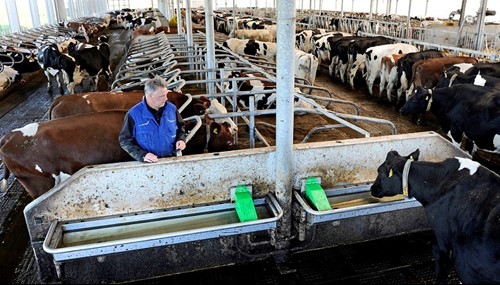"Clean drinking water for livestock belongs to sustainable farming"

This year, dairy farmer André Schilder in Spierdijk (North Holland) opened a new barn for his dairy cattle. It is a stable that can be distinguished by its attention to sustainability in all areas.
You will find plenty of Watter installations among pig farmers and poultry farmers, but the application has also been on the rise for years at dairy farms. In the construction of André Schilder's stable, sustainable materials and techniques were mainly used and attention was paid to integration into the landscape. The barn has an animal-friendly interior with spacious, soft cubicles, wide walkways and cow brushes. Ammonia emissions are minimal due to a low-emission floor made of half concrete, half rubber. A mono-manure digester is linked to the barn that produces gas from fresh manure and thus generates electricity. "We attach great importance to sustainable farming," says dairy farmer Schilder. "That means, among other things, that we want to take the best possible care of our animals. A good drinking water supply is essential here. "Schilder has been working with the Watter system since last year. This is an installation that makes a disinfectant on the spot and adds it to the water.
"Pure and clean drinking water for cattle is the basis for a healthy animal. That is sometimes underestimated" says Schilder. "I wasn't too concerned about drinking water quality for years, either." That changed with the arrival of the new barn. This was accompanied by a growth of the dairy herd from 140 to 240 cows. "This significantly increased the need for drinking water for livestock," he says. "We work with water from our own groundwater source. It can deliver a maximum of 1.5 cubic meters per hour. At peak times, immediately after milking, this is not enough. Then the cows sometimes drink more than 3 cubic meters per hour. To overcome this difference, I had a few buffer vessels installed last year. The barrels ensure that there is always enough water for the cows even at peak times" explains Schilder. "When I looked into those barrels every now and then last year, I was shocked by the degree of pollution. I started looking for ways to ensure that my cows are guaranteed clean water to drink.
I found out about Watter through a colleague. He did not make the decision overnight and compared different systems. "Experiences of other farmers with Watter are very positive. Moreover, the system requires little maintenance and electricity consumption is low. "Schilder cannot prove that his cows are actually healthier or produce better since the installation of the Wattersystem. "Milk production has increased in the past year, but the new barn will undoubtedly also play a role in this. What I perceive in any case is that the water is clean and clear; this is also evident from analyzes. And that the cows love to drink the water."
Source: LTO Ledenvoordeel (2020)



